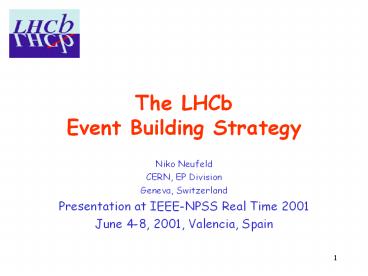The%20LHCb%20Event%20Building%20Strategy - PowerPoint PPT Presentation
Title:
The%20LHCb%20Event%20Building%20Strategy
Description:
Presentation at IEEE-NPSS Real Time 2001. June 4-8, 2001, Valencia, Spain. N. Neufeld ... Throttle to disable trigger in case of persisting contention ... – PowerPoint PPT presentation
Number of Views:22
Avg rating:3.0/5.0
Title: The%20LHCb%20Event%20Building%20Strategy
1
The LHCbEvent Building Strategy
- Niko Neufeld
- CERN, EP Division
- Geneva, Switzerland
- Presentation at IEEE-NPSS Real Time 2001
- June 4-8, 2001, Valencia, Spain
2
Overview
- Architecture of the LHCb DAQ
- Trigger rates, event size
- Event building requirements
- Gigabit Ethernet for the Readout Network
- Network topology
- Commercial switches
- Small modules
3
Main Architecture
- Data are pushed through from the Front-end links
to the CPU farm - No upwards communication
- Throttle to disable trigger in case of persisting
contention - Backpressure (Flow Control) to deal with local
contention
LHC
b
Detector
Data
rates
VELO TRACK ECAL HCAL MUON RICH
40 MHz
40 TB/s
Level 0
1 MHz
Trigger
Level
-
0
Timing
L0
Fixed latency
Front
-
End Electronics
?
Fast
4.0
s
1 TB/s
L1
40 kHz
Level
-
1
Control
Level 1
LAN
Trigger
1 MHz
Front
-
End
Multiplexers
(FEM)
Front End Links
6 GB/s
Variable latency
lt1 ms
RU
RU
RU
Read
-
out units (RU)
Throttle
6 GB/s
Read
-
out Network (RN)
SFC
SFC
Sub
-
Farm Controllers (SFC)
Variable latency
Control
50 MB/s
L2 10 ms
CPU
CPU
Storage
L3 200 ms
Monitoring
Trigger Level 2 3
CPU
CPU
Event Filter
4
Event Building
- Event Building consists of two main tasks
- The fragments of an event, originating from many
sources must be transported to one destination
(through a network/bus) - The fragments must be arranged in the correct
order as a contiguous event - Using general purpose or dedicated CPUs such as
High End PCs, Network Processors, Smart NICs
5
Readout Network
- Most likely choice for the Network Technology
Gigabit Ethernet - Also studied Myrinet
- Readout Network will be a rather large ( 128 x
128) Switching Network
- Must sustain at least 40 kHz of fragments 1000
Bytes - Should provide enough margin to increase input
rate to 100 kHz
6
Implementation of Gigabit Ethernet Switching
Network for Event Building
- Conventional
- Large Campus/MAN switches (e.g. Foundry Big Iron
120 Gigabit Ethernet ports) - Alternative
- Re-use of NP-based DAQ modules (? Presentation B.
Jost) - Basic building block is a 4x4 programmable
switch, giving full control and maximum
flexibility (in particular for flow control)
7
Network TopologyThe 2 crucial questions
- How to build a 128 x 128 network out of building
blocks with n x n inputs - when n is small, e.g. 4
- when n is big, e.g. 60
- How to optimise the usage of the installed
bandwidth, taking into account the direction of
the dataflow in the DAQ system
8
Banyan Network From Large Switches
For a rate of 100 kHz
Max load on single link 60 MB/s (50) 84 MB/s (70)
of input- or output links 240 180
Maximum fragment size 625 875
15 links per connection
20 links per connection
9
Optimised Network From Large Switches
8 links per connection 240 x 240 ports
effective load 40 _at_100 kHz
11 links per connection 174 x 174 ports
effective load 72 _at_100 kHz
10
Banyan Network for 4x4 Modules
40 kHz 40 load on input 39 load on internal
inks 128 Modules needed 100 kHz 50 load on
input- 49 load on internal links 256(!) modules
needed
11
Alternative Topology for 4x4 Modules
x 6
6 modules fully connected make a 39 x 39 module
3 modules fully connected make a 9x9 module
12
Fully connected 125x128 network
- Consists of five 39x39 modules
- Load on input ports 40 _at_ 40 kHz
- Load on internal links 34 _at_ 40 kHz
- 90 4x4 modules needed in total
13
Nitty Gritty Connectivity
Cabling and setting up the routing tables
become an issue!
14
Conclusions
- The LHCb Event Building will be done using a
Gigabit Ethernet switching network - Event fragments will flow freely from the
front-end links to the entry points of a CPU
farm, without synchronisation - The switching network has a considerable size and
cost - Optimised network topologies can take optimal
advantage of the unidirectional data-flow































